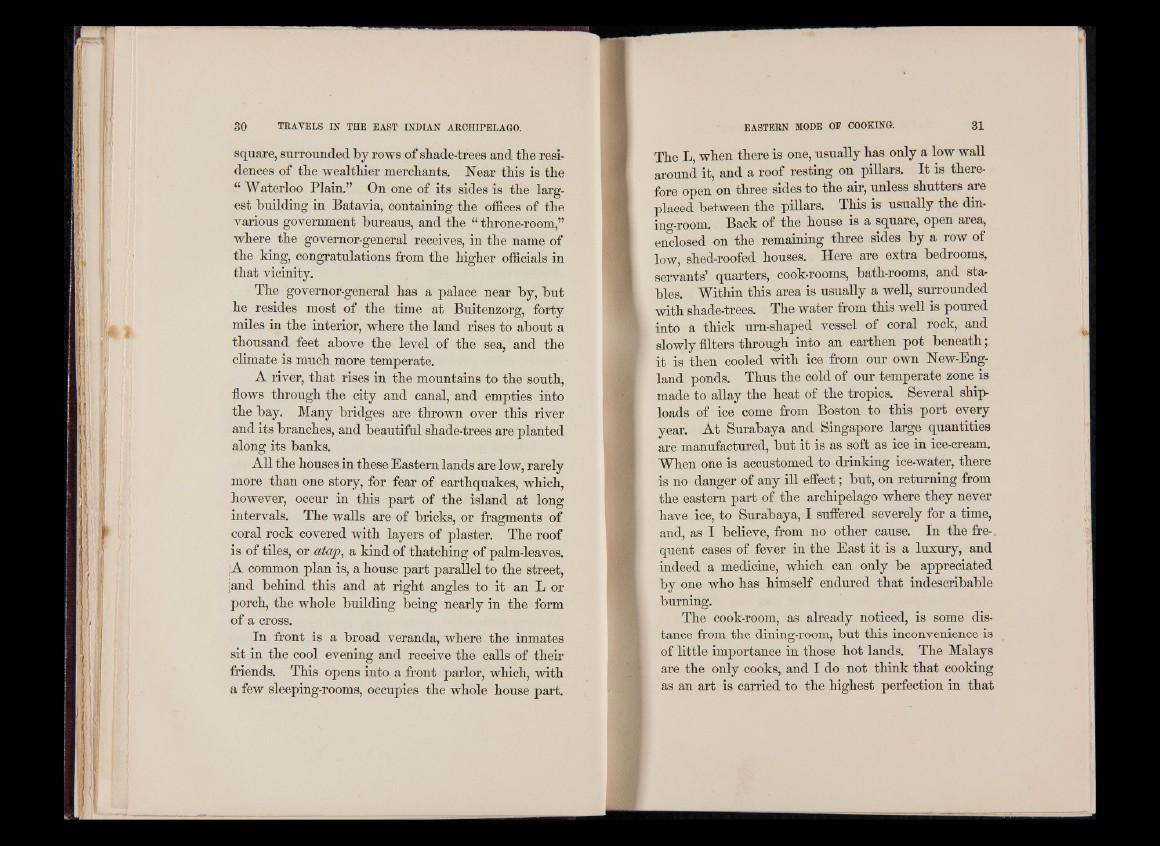
square, surrounded by rows of shade-trees and tbe residences
of tbe wealthier merchants. Near this is the
“ Waterloo Plain.” On one of its sides is the largest
building in Batavia, containing the offices of the
various government bureaus, and the “ throne-room,”
where the governor-general receives, in the name of
the king, congratulations from the higher officials in
that vicinity.
The governor-general has a palace near by, but
he resides most of the time at Buitenzorg, forty
miles in the interior, where the land rises to about a
thousand feet above the level of the sea, and the
climate is much more temperate.
A river, that rises in the mountains to the south,
flows through the city and canal, and empties into
the bay. Many bridges are thrown over this river
and its branches, and beautiful shade-trees are planted
along its banks.
All the houses in these Eastern lands are low, rarely
more than one story, for fear of earthquakes, which,
however, occur in this part of the island at long
intervals. The walls are of bricks, or fragments of
coral rock covered with layers of plaster. The roof
is of tiles, or atap, a kind of thatching of palm-leaves.
A common plan is, a house part parallel to the street,
jand behind this and at right angles to it an L or
porch, the whole building being nearly in the form
of a cross.
In front is a broad veranda, where the inmates
sit in the cool evening and receive the calls of their
friends. This opens into a front parlor, which, with
a few sleeping-rooms, occupies the whole house part.
The L, when there is one, usually has only a low wall
around it, and a roof resting on pillars. It is therefore
open on three sides to the air, unless shutters are
placed between the pillars. This is usually the dining
room. Back of the house is a square, open area,
enclosed on the remaining three sides by a row of
low, shed-roofed houses. Here are extra bedrooms,
servants’ quarters, cook-rooms, bath-rooms, and stables.
Within this area is usually a well, surrounded
with shade-trees. The water from this well is poured
into a thick urn-shaped vessel of coral rock, and
slowly filters through into an earthen pot beneath;
it is then cooled with ice from our own New-Eng-
land ponds. Thus the cold of our temperate zone is
made to allay the heat of the tropics. Several shiploads
of ice come from Boston to this port every
year. At Surabaya and Singapore large quantities
are manufactured, but it is as soft as ice in ice-cream.
When one is accustomed to drinking ice-water, there
is no danger of any ill effect; but, on returning from
the eastern part of the archipelago where they never
have ice, to Surabaya, I suffered severely for a time,
and, as I believe, from no other cause. In the fre-,
quent cases of fever in the East it is a luxury, and
indeed a medicine, which can only be appreciated
by one who has himself endured that indescribable
burning.
The cook-room, as already noticed, is some distance
from the dining-room, but this inconvenience is
of little importance in those hot lands. The Malays
are the only cooks, and I do not think that cooking
as an art is carried to the highest perfection in that